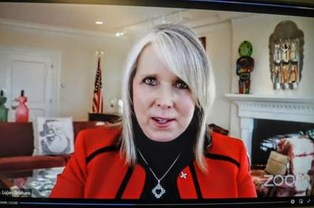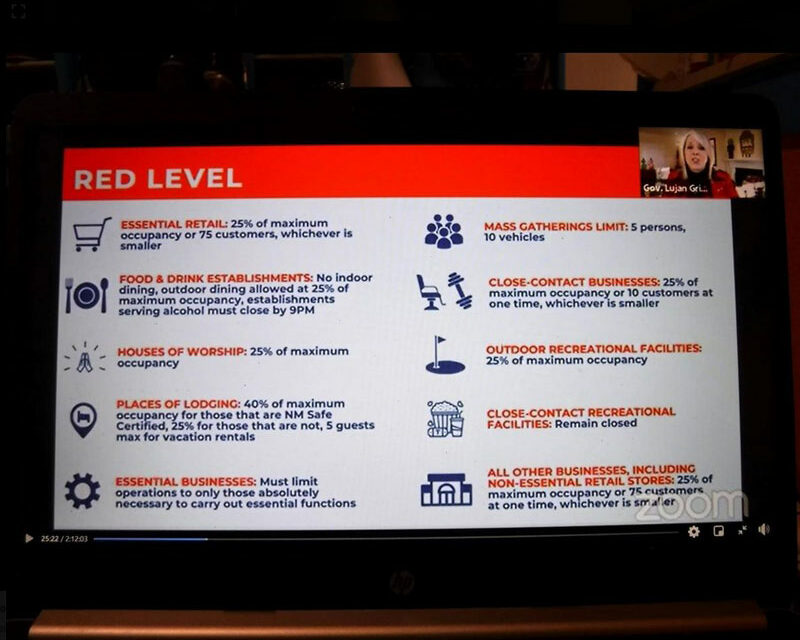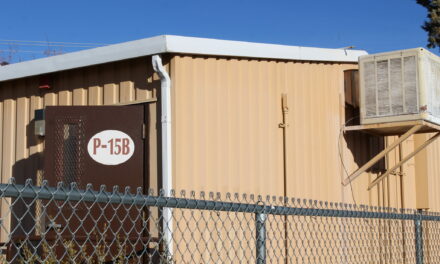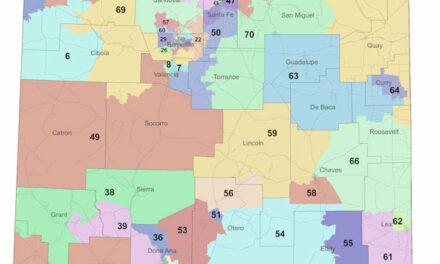On Monday, Governor Michelle Lujan Grisham introduced a new approach to battling the COVID-19 infection rate, with a goal of easing restrictions for New Mexico businesses.
In response to a ballooning positivity rate and rising 7-day gating criteria, Lujan Grisham implemented a three tiered county-by-county system on Wednesday. The system is color-coded from red to yellow to green and allows local communities to lower some restrictions on mass gatherings, restaurant dining, attendance at religious services and some nonessential businesses if the positive cases in a county start dropping.
“This will enable counties to reopen further as soon as they meet key health metrics,” she said on Monday. “What you can do to help save lives and help your community reopen has not changed.”
Counties will operate under one of three levels: Red, signifying a very high average test positivity and a very high average of new cases per-capita; Yellow, signifying a high average test positivity or a high average of new cases per-capita; and Green, signifying low average test positivity and low average of new cases per-capita..

New Mexico Governor Michelle Lujan Grisham gives an update to the state orders pertaining the coronavirus pandemic on Zoom on Monday. John Larson | El Defensor Chieftain photos
New Mexico Governor Michelle Lujan Grisham gives an update to the state orders pertaining the coronavirus pandemic on Zoom on Monday.
John Larson | El Defensor Chieftain photos
“The county-by-county framework enables counties, and the businesses and nonprofits within their borders, to operate with fewer restrictions when they slow the spread of the virus and drive down test positivity rates,” Lujan Grisham said. “It’s been a difficult year and an especially difficult past month. We must remain as vigilant as ever to contain and beat the virus; we also must look for ways to lessen the burden on our communities wherever possible, while never swerving from our top priority – protecting New Mexicans and saving lives.”
Counties where the virus is more prevalent will operate under more restrictive public health measures. Likewise, counties where the virus has been or is being suppressed will operate under less restrictive measures.
As of Monday, 32 of the state’s 33 counties are at the Red Level. At this level, almost every category of business or nonprofit entity may operate – but with limited capacity and reduced operations, owing to the very high risk of viral spread.
Red Level:
• Essential businesses (nonretail): No capacity restrictions but must limit operations to only those absolutely necessary to carry out essential functions
• Essential retail spaces: 25 percent of maximum capacity or 75 customers at one time, whichever is smaller
• Food and drink establishments: No indoor dining permitted; 25 percent of maximum capacity for outdoor dining; any establishment serving alcohol must close by 9 p.m. each night
• Close-contact businesses: 25 percent of maximum capacity or 10 customers at one time, whichever is smaller
• Outdoor recreational facili capacity (unless required to have less capacity under the state’s COVID-Safe Practices)
• Close-contact recreational facilities: Remain closed
• All other businesses: 25 percent of maximum capacity or 75 customers at one time, whichever is smaller
• Houses of worship: 25 percent of maximum capacity
• Places of lodging: 40 percent of maximum occupancy for those that have completed NM Safe Certified training; 25 percent of maximum occupancy for all others; five guests maximum for vacation rentals
• Mass gatherings limit: five persons, 10 vehicles
Yellow level:
• Essential businesses (non-retail): No capacity restrictions but operations must be limited to only those absolutely necessary to carry out essential functions
• Essential retail spaces: 25 percent of maximum capacity or 125 customers at one time, whichever is smaller
• Food and drink establishments: 25 percent of maximum capacity for indoor dining for those that have completed NM Safe Certified training; 75 percent of maximum capacity for outdoors dining; any establishment serving alcohol must close by 10 p.m. each night
• Close-contact businesses: 25 percent of maximum capacity or 20 customers at one time, whichever is smaller
• Outdoor recreational facilities: 25 percent of maximum capacity (unless required to have less capacity under the state’s COVID-Safe Practices)
• Close-contact recreational facilities: Remain closed
• All other businesses: 25 percent of maximum capacity or 125 customers at one time, whichever is smaller
• Houses of worship: 25 percent of maximum capacity
• Places of lodging: 60 percent of maximum occupancy for those that have completed NM Safe Certified training; 25 percent of maximum occupancy for all others; five guests maximum for vacation rentals
• Mass gatherings limit: 10 persons; 25 vehicles
Green level:
• Essential businesses (non-retail): No capacity restrictions but operations must be limited to only those absolutely necessary to carry out essential functions
• Essential retail spaces: 50 percent of maximum capacity
• Food and drink establishments: 50 percent of maximum capacity for indoor dining for those that have completed NM Safe Certified training; 75 percent of maximum capacity for outdoor dining
• Close-contact businesses: 50 percent of maximum capacity
• Outdoor recreational facilities: 50 percent of maximum capacity (unless required to have less capacity under the state’s COVID-Safe Practices)
• Close-contact recreational facilities: Remain closed • All other businesses: 50 percent of maximum capacity
• Houses of worship: 50 percent of maximum capacity
• Places of lodging: 75 percent of maximum occupancy for those that have completed NM Safe Certified training; 40 percent of maximum occupancy for all others; 10 guests maximum for vacation rentals
• Mass gatherings limit: 20 persons, 100 vehicles
The county-by-county framework will permit counties – and the businesses and nonprofit entities within their borders – to operate under less restrictive public health measures when health metrics demonstrating the extent of the virus’ spread and test positivity within those counties are met.
The new red-to-green system is similar to the county-based approach adopted by California and some other states. Earlier in the pandemic, Lujan Grisham had largely stuck to statewide health orders and resisted calls to ease restrictions in any one county. Monday she said the new restrictions provide an incentive for local leaders and communities to boost testing and limit the spread of the virus.
“We get to green by exhibiting safe-covid practices. We can do this,” Lujan Grisham said. “But it will take time. Like a semitruck, you can’t stop on a dime.”
When a county fails to meet the specified metrics for a given level upon the biweekly update of the map, it will begin operating at the next most restrictive level within 48 hours. When a county meets the specific metrics for a less restrictive level, the county may begin operating at that level of restrictions upon immediate effect of the department’s biweekly update of the map.
The two key health metrics that will used to determine where a county sits within the tiered framework are identified within the state’s gating criteria, the set of public health data points tracked and measured by the state Medical Advisory Team and others: The per-capita incidence of new COVID-19 cases and average COVID-19 test positivity over a statistically meaningful period of time. These are also the same metrics the state has used to classify counties for the purposes of gauging the risk level for limited public school re-openings and limited nursing home visitations.
To move out of the red level, which all but one of New Mexico’s counties will start in, a county must hit at least one of two statistical targets: one on the share of virus tests that come back positive, the other on the number of new cases per capita each day.
Persuading more residents to get tested, for example, could help a county drive its test positivity rate below 5 percent, allowing it to move into the health tier that permits indoor restaurant dining at partial capacity.
Socorro County’s positivity rate now stands at 15.8 percent.
“Nothing about this virus has changed,” Lujan Grisham said “And what we can all do to fight it – and to help members of our local communities avoid infection and get back to more safe dayto-day activities – hasn’t changed either. Avoid gatherings. Wear a facemask. Avoid spending time with non-household members. Stay at home whenever – whenever – you can. These are best and indeed our only tools as we seek to prevent and minimize the illness and suffering and death so many of our neighbors in this state continue to grapple with.”
No matter a county’s level, the following requirements remain in place statewide:
• Facemasks are required to be worn in public.
• Businesses that accrue a significant number of positive COVID-19 cases within their workforce in a two-week span are subject to temporary closure by the Department of Health.
• An essential business may be permitted to continue operating if the Department of Health and Environment Department determine the business is a necessary provider of goods or services within the community in light of geographic considerations.
• Businesses that test each employee every two weeks and regularly provide contact training data to the Environment Department shall not be subject to closure under this framework
• This applies only to food and drink establishments; close-contact businesses; places of lodging; retail spaces; and other other businesses which members of the public regularly visit.
• The closure process is triggered if four or more rapid responses occur within a 14-day period. The New Mexico Department of Health maintains an official map displaying each county’s current level on its designated COVID-19 webpage, cv.nmhealth.org.
To capture an average over a period of time that accurately conveys the state of the spread of the virus in each county, the agency updates this map every other Wednesday.
Last week, state lawmakers passed and Lujan Grisham signed a $330 million relief package aimed at helping out-ofwork New Mexicans and certain businesses hit hard by the pandemic.

















